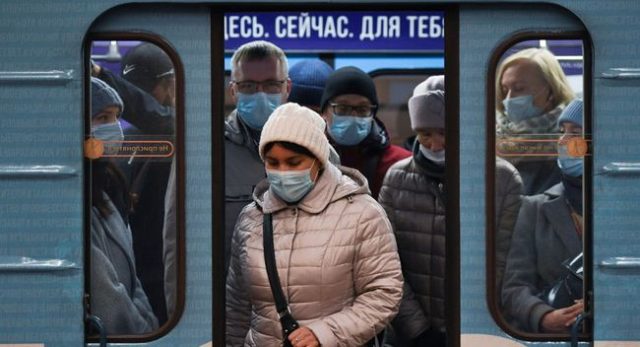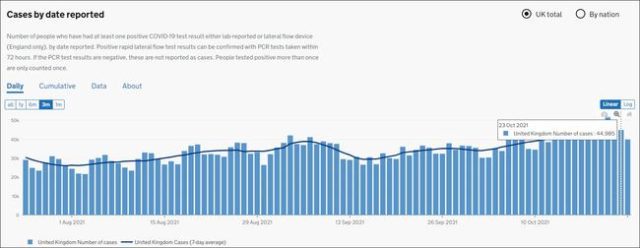WHO: Only Europe has seen a surge in new COVID-19 cases
- Normal Liver Cells Found to Promote Cancer Metastasis to the Liver
- Nearly 80% Complete Remission: Breakthrough in ADC Anti-Tumor Treatment
- Vaccination Against Common Diseases May Prevent Dementia!
- New Alzheimer’s Disease (AD) Diagnosis and Staging Criteria
- Breakthrough in Alzheimer’s Disease: New Nasal Spray Halts Cognitive Decline by Targeting Toxic Protein
- Can the Tap Water at the Paris Olympics be Drunk Directly?
WHO: Only Europe has seen a surge in new COVID-19 cases while declining in US
- Should China be held legally responsible for the US’s $18 trillion COVID losses?
- CT Radiation Exposure Linked to Blood Cancer in Children and Adolescents
- FDA has mandated a top-level black box warning for all marketed CAR-T therapies
- Can people with high blood pressure eat peanuts?
- What is the difference between dopamine and dobutamine?
- How long can the patient live after heart stent surgery?
WHO: Only Europe has seen a surge in new COVID-19 cases while declining in US.
Lockdowns, a surge in confirmed cases, and indecision in vaccinations…These conditions constitute the beginning of the second winter COVID-19 pandemic in Europe, which not only brought chaos to Eastern European countries, but also brought uncertainty to Western European countries. .
On October 25th, the Associated Press and CNN quoted the WHO’s statement last Wednesday (20th) that although the supply of vaccines this winter is more comfortable than the same period last year, Europe has become last week. The only region in the world with a surge in confirmed cases of COVID-19s. The WHO also reported that the area has seen a surge in the number of cases for three consecutive weeks.
According to data from the European Center for Disease Control and Prevention (ECDC), the current epidemic in Eastern European countries and Russia is very serious, and people there are fighting the rising number of confirmed cases and deaths. Among them, most of the deaths have not received the COVID-19 vaccine, and the vaccination rate there is only about 24%.
Russia, Ukraine, and Romania are the most severely affected Eastern European countries. The vaccination rate there is only about 30% at most, and the number of deaths has recently been among the highest in the world.
In contrast, the vaccination rate in Western European countries is much higher, but the epidemic is also worsening. Take the United Kingdom as an example. Although the vaccination rate is very high, the epidemic has not been controlled due to the negative policy adopted by the government, but has worsened. In addition, the United Kingdom has also been identified by many Western European countries as the “culprit” of the spread of the epidemic in their country.

Screenshot of CNN report
European experts believe that there are multiple reasons for the rebound of the epidemic. As the temperature continues to drop, the effectiveness of vaccines may also decline over time. Taking the UK as a typical example, some countries have relaxed or even lifted strict epidemic prevention measures. In Eastern Europe, where vaccination is slow, in addition to a surge in confirmed diagnoses, the proportion of deaths is also alarming.
Eastern Europe and Western Europe seem to be different, but in fact the same
According to the Associated Press, in the weekly assessment of the COVID-19 epidemic released by the WHO on the 20th, there were approximately 2.7 million new confirmed cases and more than 46,000 deaths worldwide in the previous week. The data is basically similar.
However, the number of new confirmed cases of COVID-19 pneumonia in Europe increased by about 7% compared with the previous week, with a total of about 1.3 million new cases. This is also the only region in the six WHO regions where the number of confirmed cases has increased. The WHO European Office stated in a statement on the same day that one billion doses of the COVID-19 vaccine have been vaccinated across the European continent, but the uneven vaccination situation still poses a serious threat to the region.

Screenshot of Associated Press report
The WHO also said that the two regions with the highest rates of COVID-19 pneumonia infections are Europe and the Americas. Globally, the United States reported the most new confirmed cases last week, exceeding 580,000, but it was still down from the previous week. It’s about 11%.
According to a CNN report, last Thursday (21st), when European countries encountered a new round of epidemics, Latvia became the first country in the EU to re-implement restrictions. The lockdown will continue until November 15. On October 11, Latvia has declared a state of emergency again.
On October 23, local time, there were 2,932 new confirmed cases of COVID-19 pneumonia in Latvia. The current average infection rate per 100,000 people in the past 14 days is 1605.9, which is not only the highest among the three Baltic countries, but also the first in the European Union. While the number of cases in the country has soared, the vaccination rate is very low. Only about 50% of adults receive two doses of the vaccine at the same time, which is lower than the EU’s average vaccination rate of 74.6%.
Compared with Eastern European countries, the vaccination rate of some Western European countries can be said to be “almost comprehensive coverage”, but the number of confirmed cases is still rising.
On October 23, the infection rate of COVID-19 pneumonia in Germany rose to 100 per 100,000 for the first time since May this year. According to data from the European Centers for Disease Control and Prevention, Belgium and Ireland have the highest infection rates in Western Europe, with 325.76 and 432.84 infections per 100,000 people, respectively.
Belgian Health Minister Frank Vandenbrouck told the Belgian VRT Broadcasting Company on October 20 that the country is in the midst of the fourth wave of epidemics. According to Reuters, currently about 74% of people in Belgium have been vaccinated against the COVID-19. Some officials said that the vast majority of hospitalized patients with COVID-19s have not been vaccinated.
According to data from the National Institute of Public Health and Environment (RIVM) in the Netherlands, as of the 21st, the total number of new cases this week was 25,751, and the death toll was 48. Since the Netherlands relaxed the ban on epidemic prevention on September 25, the number of new cases has been increasing.
According to the British “Guardian” report, the number of new daily cases in Spain in the past 7 days has increased by 17%, while that in Italy has increased by nearly 6%.
Peter Drobac, a global health expert at the Said School of Business at the University of Oxford in the United Kingdom, said that although the very different vaccination rates seem to push Eastern and Western Europe on two separate tracks, they are accompanied by a restart of economic activity. , The arrival of the cold winter, more and more people gathering indoors, highly infectious delta mutant strains and new mutant strains, etc. The situation in these two regions is the same, that is, the epidemic prevention measures have been relaxed. At the same time, the infection rate continues to be pushed up.

The increase or decrease in the number of confirmed cases in European countries in the past two weeks (pictured from the Reuters Epidemic Data System, the red arrow indicates the increase in the number, and the green arrow indicates the decrease in the number)
The increase or decrease in the number of confirmed cases in countries in the Americas and Africa in the past two weeks.
Low vaccination rate, Eastern European countries are defeated
The CNN report mentioned that although the number of confirmed cases in some Western European countries may be high, due to vaccination, the number of deaths and hospitalizations in those places is still slightly better than Eastern European countries.
According to the data website “Our World in Data” created by the Oxford University team, Hungary accounts for 62% of the total population in terms of the number of people who have received at least one dose of the COVID-19 vaccine. 19% of people do this.
Reuters also introduced that among the five countries with the largest number of new deaths from COVID-19 pneumonia every day, three of them are from Eastern Europe. They are Russia, Ukraine and Romania.

Russian people wear masks to travel. Pictured from Russian media
From October 25, local time, Romania will re-impose curfews and restrictions on access to public places, and schools will also be closed for two weeks. In October, the number of COVID-19 infections and deaths in Romania surged, and the medical and health system has reached saturation. The country’s COVID-19 vaccination rate is about 29%.
In fact, as an EU country, Romania’s plight is not due to the shortage of vaccines. Like some countries in the Baltic Sea or even the Balkans, Romania’s vaccination work has been subject to factors such as public hesitation, poor government information transmission, and skepticism by those in power. Obstacles.
Due to the rebound of the epidemic, the vaccination rate in Romania began to rise this week. On October 22, local time, more than 86,000 people received the first dose of the COVID-19 vaccine, setting a record for the number of people vaccinated in a single day.
In Romania’s neighboring Ukraine, from October 21 to the present, the number of new confirmed cases every day has exceeded 20,000, reaching a new high since the outbreak. For this reason, Ukrainian President Zelensky publicly called on the public to be vaccinated against the COVID-19 in a TV interview, calling this the only way to replace the lockdown of cities and towns.
He said: “Standing at this crossroad, there are now two roads, vaccination or lockdown. We face such challenges and choices every day. For economic reasons, I am totally opposed to lockdown.”
However, according to Reuters, after the number of deaths in a single day in Ukraine exceeded 600 (614), as of the 22nd, Ukraine has announced the closure of schools in the hardest-hit areas of the epidemic. Before boarding all public transportation into the capital, Ukraine has announced the closure of schools. You must have a vaccination certificate or a negative test report for the new coronavirus.
Similarly, Russia is also experiencing the most severe period of the epidemic. Affected by the COVID-19 epidemic, on October 20 local time, Russian President Vladimir Putin officially announced that October 30 to November 7 are non-working days in Russia. Putin mentioned that if necessary, non-working holidays can be extended after November 7.
Some Russian government officials admitted that Russia is facing a “terrible winter.” In recent days, the highest number of confirmed cases and the number of deaths in a single day in Russia has continuously set new records. On the 20th local time, the number of new deaths in Russia reached 1,028, a record high after the previous day (1,015).
Russia Epidemic Curve Data from Johns Hopkins University
Vaccination situation in Russia Data from “Our World in Data”
“Of course, informing and explaining the necessity and importance of vaccination is not all that needs to be done.” Russian Presidential Press Secretary Dmitry Peskov (Dmitry Peskov) confronted reporters and admitted that the Kremlin is very important to the country’s vaccines. The low vaccination rate is partly responsible, but he also said: “At the same time, our citizens also need to take a more responsible attitude towards vaccination.”
If the epidemic prevention is unscientific, the vaccine is not a panacea…
So, what about some Western European countries where vaccination rates are already quite high? The epidemic is still getting worse, how to deal with it?
Drrobuck, an expert at the Said Business School of Oxford University in the United Kingdom, said that Western Europe will not reach the level of crisis that people have witnessed in the past. Because shelter hospitals are being built and vaccines have also changed the situation of epidemic prevention, Europeans have reason to be optimistic.
But at the same time, he added that, judging from the situation in the UK (both the vaccination rate for one and two doses is around 70%), the COVID-19 vaccine is not a “silver bullet” that can end the epidemic.
According to the epidemic data released by the British government on October 23, the number of new confirmed cases of COVID-19s in the UK in the past seven days set the record for the highest number of new confirmed cases in a single week since late July.
According to data, 44,985 new cases of COVID-19s were newly confirmed in the United Kingdom on the 23rd, and 333,465 new cases were newly added in the past 7 days. This is a 15% increase from the previous 7-day number of new cases and the highest number of new cases in a single week since July 21. In addition, the number of deaths from the COVID-19 in the UK has risen by 12% in the past 7 days. On the 21st, the United Kingdom added 52009 confirmed cases of COVID-19, which is the first time in more than three months that the number of new cases exceeded 50,000 in a single day.

Daily new confirmed cases in the UK in the past three months. Picture from the official website of the UK government

In July of this year, British Prime Minister Johnson announced the complete unblocking of the English region and the abolition of almost all epidemic restrictions. In the face of the fierce Delta mutated COVID-19 virus, he directly “lay flat”. Johnson also defended his unblocking plan in Parliament, calling the relaxation of restrictions a “balanced policy.”
But today, the United Kingdom has the largest number of new confirmed cases every day in Western Europe. Many Western European countries also believe that the United Kingdom is the “culprit” of the surge in Western Europe and criticized Johnson’s epidemic policy.
Some local Spanish news media questioned: “Why is there more than 40,000 new cases in the UK every day, and why is it the European country with the largest number of infections?” France’s L’Express commented on the UK’s policy and Management is disastrous and lacks foresight. Italy’s “Evening Post” said: “Fear has returned to London. How many British people are willing to give up their lives for freedom?”
It’s not just “neighbors” who can’t stand it, but even the British themselves can’t stand it. According to reports, the country’s health experts and medical alliance have pleaded with the British government to follow the example of other European countries and re-implement measures such as mask regulations or vaccine passes to prevent the implementation of more escalated restrictions such as lockdowns.
However, despite the rising number of hospitalizations and deaths, the British government rejected these recommendations. The head of the Royal College of Emergency Nursing, Katherine Henderson, told Sky News on the 24th that due to the aggravation of the epidemic, medical services across the UK are overwhelmed, and emergency departments in various regions have already queued up long queues of ambulances outside the door. Overwhelmed.
CNN pointed out that although British Prime Minister Johnson urged people over the age of 50 and people at high risk of COVID-19 pneumonia to start vaccinating booster shots, this is far from enough with the current surge in cases. At present, in addition to the raging spread of Delta mutant strains in the UK, the country’s health department has also discovered other new types of mutant viruses in genetic sequencing, which some people call “Delta + mutant strains” (Delta Plus, AY.4.2).

Screenshot of BBC report
Henderson said that relying on vaccines and unvaccinated people (such as children, infected people) to create “herd immunity composed of naturally infected people and vaccinated people” is a dangerous strategy. “The problem with this is that not only does it lead to high hospitalization rates and high mortality rates, but it also doesn’t work (herd immunity).”
According to data from the European Center for Disease Control and Prevention, although Ireland has one of the highest vaccination rates in Europe, with 92% of the population fully vaccinated, Ireland is planning to postpone the cancellation of epidemic restrictions as the epidemic in the UK is out of control. .
On the 20th, Mike Ryan, the executive director of the WHO emergency project, said that Europe should not fall into endless lockdowns and deaths like last winter, like “sleepwalking”. No one knows that the COVID-19 epidemic is in two What will happen in a month or three months must be more cautious and careful.
WHO: Only Europe has seen a surge in new COVID-19 cases while declining in US.
(source:internet, reference only)
Disclaimer of medicaltrend.org
Important Note: The information provided is for informational purposes only and should not be considered as medical advice.



